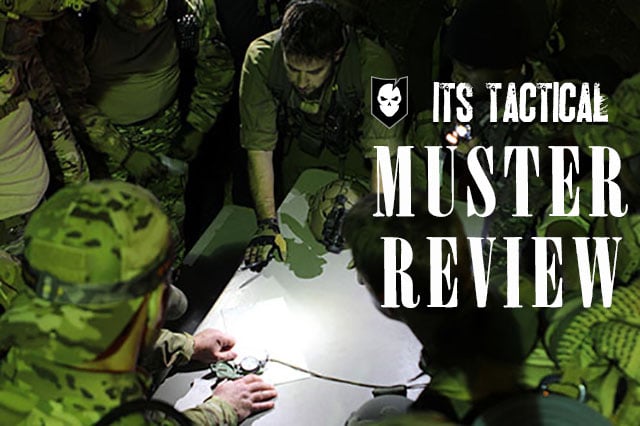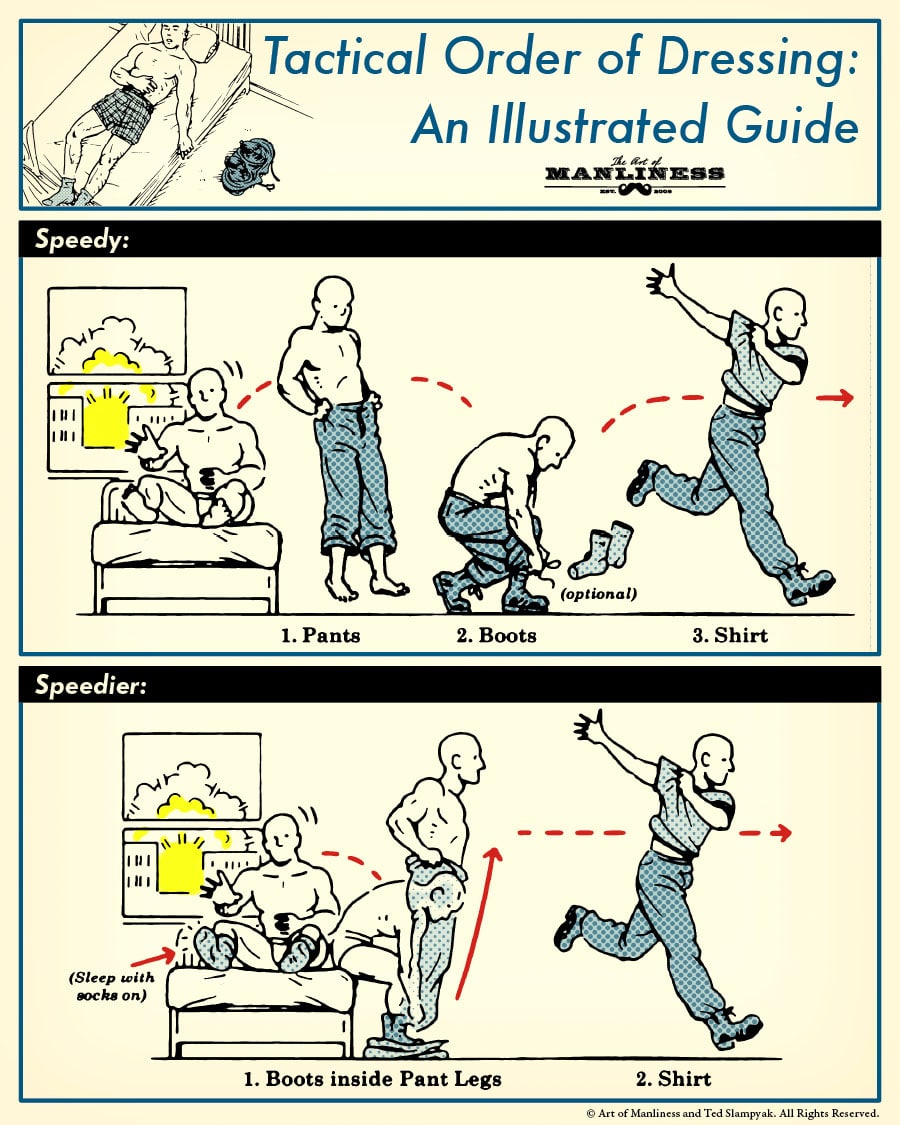It’s late Friday night and you’re walking to your car after a fun evening with your friends downtown. As you turn the corner down an unlit side street, you see a shadow dart across the wall and hear footsteps. The hairs on your neck stand straight up. You quicken your pace, but the other footsteps speed up as well. You look around trying to make out shapes in the dark, when out of nowhere a fist connects with your cheekbone. The sucker punch takes you to the ground and you can feel your wallet being taken from your back pocket.
Before you have time to react, your assailant has disappeared back into the cover of darkness.
You really could have used a flashlight.
If you’re like me, you typically think of flashlights as something you keep in your kitchen drawer in case the power goes out, or as what you bring along on an infrequent camping trip so you can find your way back to the tent after you take a middle-of-the-night leak. But according to Mike Seeklander, firearms and tactical trainer with Shooting Performance, a flashlight is something every man should have with him at all times. I met Mike over at the US Shooting Academy here in Tulsa to go over the ins and outs of using a flashlight in a tactical situation. Here’s what he told me.
What Is a Tactical Flashlight?
In today’s post we’re not talking about just any old flashlight. We’re talking about tactical flashlights. What makes a flashlight tactical? A tactical flashlight is simply a flashlight that’s been designed for tactical (i.e. military or police) use. Many tactical flashlights are designed to be mounted to a weapon for low-light shooting. They’re typically smaller than traditional flashlights, emit much more light, and are made of weapon-grade aluminum for maximum durability. While tactical flashlights are designed primarily for military and police units, as we’ll see below, they’re also a really handy everyday and personal defense tool for the average civilian.
Why Every Man Should Carry a Flashlight
Before we even get into the tactical and self-defense uses of a flashlight, let’s talk about why you should start carrying one even if you don’t plan on using it to thwart would-be attackers. Next to a pocket knife, a small, tactical flashlight is one of the most useful and versatile tools a man can have in his Every Day Carry kit.
I can’t count the number of times I’ve been in a situation where a flashlight would have been handy, but I was left stumbling in the dark. Take the other day for example. I was trying to fix a connection on our TV’s audio output, but I couldn’t see a thing behind the stand. So I had to go rummage around my house looking for a flashlight. I could have saved myself about 15 minutes if I simply had a small flashlight tucked in my pocket along with my knife.
And as the residents of the Eastern seaboard learned firsthand last week, electrical power can go out at any time and for long periods. Having a flashlight on you can save time and toe stubs as you navigate about your darkened apartment.
And, besides helping you fix wire connections or navigating your home after a power outage, a flashlight can also be used as an effective self-defense tool.
Flashlights: The Most Underestimated Tool for Personal Defense
If you use a handgun as a personal defense weapon, a flashlight is vital for low-light shooting. Not only does it help you to identify your target, but it also allows you to see your gun sights in the dark. Even if you don’t carry a gun for personal defense, a flashlight, when used correctly, can be very handy in tough situations. (We’ll talk more below about using a flashlight when armed or unarmed.) They can be taken into places like movie theaters or airplanes where guns are banned, and are great for men who live in countries with strict weapons laws, but who still want to carry something for personal defense.
There are two important self-defense functions that a tactical flashlight serves, plus one bonus use.
Helps identify threats. Attackers often use the cover of darkness as an advantage. A bright flashlight can help identify threats in a low-light environment and eliminate the advantage of an attacker stalking in the shadows. Simply shining a light on a bad guy can be enough to get him to take off.
Momentarily disorients attackers. Have you ever had a bright light shined in your eyes when it was dark outside? You probably felt disoriented and even blinded for a bit. You can take advantage of that natural reaction to bright light to defend yourself against would-be attackers.
Whenever you encounter a possible threat, shine your flashlight directly in their eyes, or as Mike says, “dominate their face.” Your assailant will likely reach his hands up to his face and experience three to four seconds of disorientation and semi-blindness. That gives you enough time to either flee or attack.
Bonus use: Improvised weapon. Some tactical flashlights have a serrated or toothed bezel. Manufacturers advertise these specialty bezels as a tool that can be used to break car windows in an emergency. But according to Mike, breaking a window with a small, tactical light is easier said than done. “Me and a bunch of Military Special Operations personnel tried for hours to break a car window with the toothed bezel of a small tactical flashlight. We never broke it.”
While the bezel on a tactical flashlight isn’t going to break windows, it can be used as an improvised striking device during an attack. After you’ve shined the light in your attacker’s eyes and disoriented him, strike his face with the toothed bezel as hard as you can. The motion should be like stamping him with a giant rubber stamp.
Mike says to be careful with the toothed bezeled flashlights when flying. He had one taken away by a TSA agent because it was deemed a “striking tool.” When in doubt, put your flashlight in your checked bag.
Which Flashlight Is the Best Flashlight in Tactical Situations?
So a tactical flashlight is a great self-defense tool. Which one should you get? There are literally nearly 100 different models on the market. The one you choose will typically come down to your budget and personal preference. But here are a few things you should look for when selecting a tactical flashlight for everyday carry:
- Small. You want something small enough to carry in your pocket every day. Your flashlight should be no bigger than the size of your palm.
- At least 120 lumens of light output. For a flashlight to be an effective self-defense tool, it needs to be bright enough to disorient attackers. Anything less than 120 lumens just won’t get the job done.
- Simple. There are flashlights on the market that have strobe or SOS functions, or flashlights that allow you to change the brightness of your light output depending on how many times you push the on/off switch. While many tactical flashlight users swear by these features, Mike recommends keeping things simple. You don’t want a flashlight so complex that you have a hard time using the primary feature (bright light) when you really need it. A simple on/off switch should do the trick.
- Waterproof. You want a flashlight that will work in ALL situations. Get a flashlight that’s waterproof so it will work even in the rain or other wet conditions.
- Ruggedly constructed. Your flashlight will likely see a lot of action, so get something that will withstand the use. Look for one made from hard anodized aluminum. It’s a tough, yet light metal. Also, make sure the metal on the flashlight is machined so that it’s easy to grip. You don’t want to drop your flashlight when you need it most.
- LED or incandescent? Mike prefers LEDs because in his experience incandescent bulbs break easily when dropped while LEDs can withstand a beating. Incandescent bulbs also aren’t very energy efficient. You’ll burn through bulbs and flashlight batteries faster than you will LED bulbs.
Suggested Tactical Flashlights
Surefire P2X Fury Dual Output LED. After the tragic shootings in Aurora, former Navy SEAL Brandon Webb wrote an article about what citizens could do to help protect themselves in a similar situation. His number one recommendation? Carry a super bright tactical flashlight with you at all times. He recommended the Surefire P2X Fury Dual Output LED flashlight. This bad boy puts out 500 lumens of light. Downside of the Surefire is price. This little guy will set you back $121. Ouch.
Streamlight 88031 Protac Tactical Flashlight 2L. If you’re looking for a more affordable tactical flashlight, check out the Streamlight ProTac. Its 180 lumens of light output is more than enough to blind an attacker so you can escape and evade. $44.
NiteCore Extreme LED Flashlight. Mike’s go-to flashlight. His has taken a beating and been through the wash three times, but still works like a champ. Unfortunately, it appears NiteCore no longer makes this flashlight, but you still might find some places that still sell it new. If all else fails, look for a used one.
How to Safely Maneuver in a Dark Space With a Flashlight
When you hear something go bump in the night and you think that something might be armed and dangerous, there’s a particular way you want to maneuver in a dark space when using your flashlight to maximize your safety. Here’s how to do it.
Try the light switch first. If you’re in a low-light environment, your first step should be to simply turn on the main light source if it’s convenient and safe to do so. Don’t be like the forensics teams on CSI. The more light you have, the better.
Of course, there will be situations when turning on the main light source is impossible — you’re not near the switch, electricity is out, you’re outside, etc. In that case you’ll need to use your flashlight. But if you suspect there’s an attacker nearby with a weapon, you’ll need to use your flashlight in a certain way to keep yourself safe.
Light on, scan, light off, move. When you’re maneuvering in a low-light environment and believe there’s an armed attacker nearby, you don’t want to leave your flashlight on the entire time. That just makes you an easy target. Instead, follow this sequence:
- Light on
- Scan environment. Look for threats.
- Light off
- Move
- Repeat
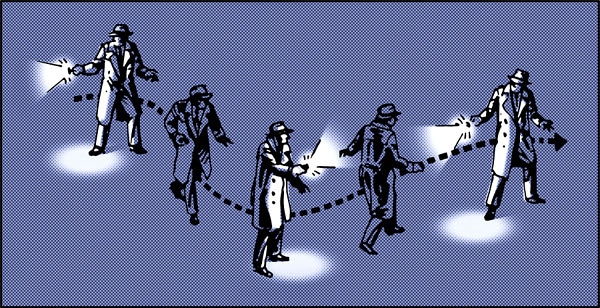
When maneuvering in a low-light environment, don’t leave your flashlight on the entire time. That just makes you an easy target. Instead follow this sequence: turn light on, scan, turn light off, move.
Your threat will likely shoot at or attack where they last saw the light from your flashlight. By turning off your light and then moving, you’ll increase the chances that you’re not standing where your threat is going to shoot or attack.
How to Use a Tactical Flashlight When You’re Unarmed
Even if you don’t carry a firearm, you can use a small flashlight to defend yourself from a would-be assailant. Whenever you encounter a threat, shine the light on his face, and dominate his eyes. The bright light will cause momentary blindness and disorientation, giving you enough time to flee or engage your attacker. If you don’t have any combatives training or if you don’t know whether or not your threat is armed, your best option is to flee. No need for the macho stuff; living is manlier than having your gut poked through with a knife.
If you must engage your attacker, a quick, hard hit to the face with the toothed bezel on your tactical flashlight should incapacitate him enough for you to get away. Low, hard kicks to the groin or knees are also effective in this situation as he won’t be able to see them coming with the light shined in his eyes.
How to Hold a Flashlight When Using a Gun
If you use a gun for personal defense, you’ll definitely want to learn how to manipulate and fire the weapon with a flashlight. According to FBI statistics, the likelihood of having to use your weapon in a low-light situation is much greater than that of using in broad daylight. While weapon-mounted lights and night sights both serve a purpose when using a gun in a dark environment, both have downsides as well. The big issue with weapon-mounted lights is that because the flashlight is mounted on your gun, you have to point your gun at the object you want to illuminate. Not very safe. The problem with night sights is that while you can see your sights so you can align them, if it’s too dark (and you don’t have a flashlight), you can’t see the target and whether he/she/it is actually a threat. Plus, night sights can be pretty dang expensive and might not be in your budget.
When used in a certain way, a small, tactical flashlight can allow you to safely assess your situation without pointing your gun at a non-threat (solving the issue with weapon-mounted lights) and you’ll be able to see your sights and your target without dropping a big chunk of change (solving the issues with night sights).
Below, we’ll first take a look at the techniques Mike doesn’t recommend using when carrying both a flashlight and a gun, and then explain the method he prefers.
The Disadvantages of Two-Handed Flashlight-Gun Techniques
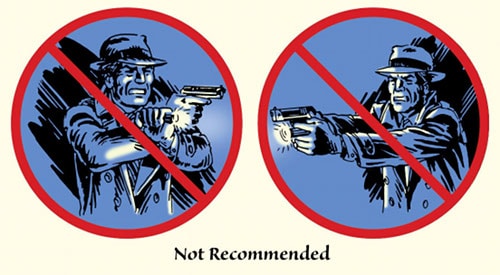
The first two-handed technique for holding both gun and flashlight involves holding the flashlight in front of you with your non-dominant hand, while resting your gun-holding hand on top, as seen in the left-side image above. You’ll oftentimes see this technique being done on cop shows. The second two-handed approach is called the Rogers technique. The Rogers technique is a modification of the normal shooting grip with the flashlight trapped between the first and second or second and third finger of your non-dominant hand, as seen in the right-side image above.
While Mike thinks both grips have some merit, he also believes each has some downsides that compromise your safety and the safety of others when using a firearm in a low-light situation.
The big downside of both two-handed techniques is that if you want to shine a light on something, you also have to point your gun at that object or person. While you may be practicing good safety measures by keeping your finger off the trigger, you have to accept the risk that you’re pointing your muzzle at a potential non-threat, like your kiddo or your weird neighbor.
Moreover, two-handed techniques may leave you vulnerable to a head strike. With both hands holding the gun and flashlight, you have no way of protecting your head from a swing from a hidden attacker.
Another issue Mike has with two-handed techniques is that, with the exception of the Rogers technique, none of them really offer any decent recoil control over one-handed shooting.
Finally, if you’re not careful, it can be easy to activate your gun’s magazine release when using a two-handed technique.
Mike’s Recommendation: The Eye Index Technique
Instead of a two-handed shooting technique, Mike recommends and teaches a one-handed approach that he calls the “Eye Index Technique.” The Eye Index Technique is a modification of a gun/flashlight technique taught to Federal Air Marshals called the “Neck Index.”
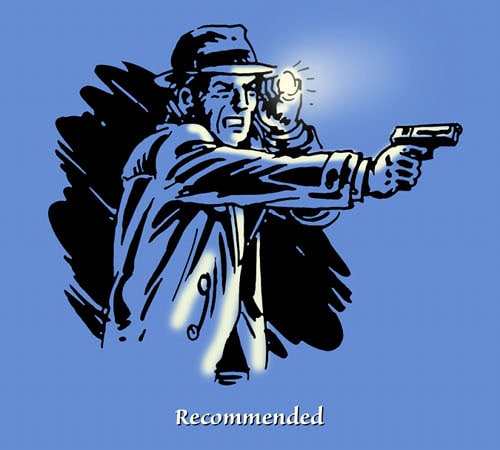
To perform the Eye Index Technique follow these steps:
1. Hold your tactical flashlight in your non-dominant hand so that the light is by your eye. This serves two purposes. First, the placement of the flashlight here will illuminate not only your target, but also your gun sights. You need to see both in order to hit your target. Second, having your hand up by your head like this offers you protection from any head strikes that might come your way.
2. Extend your gun hand out. Because you’ll be firing with just one hand, you’ll need to modify the way you hold the gun for recoil control. Grip the gun tighter with your dominant hand than you would if you were firing with two hands, yet ensure that your trigger finger remains as relaxed as possible. Your thumb should be angled up slightly to ensure that there’s equal pressure on the rear back strap of the gun. Don’t extend your arm all the way out. Leave a slight bend in your elbow. This will help keep your arm behind the gun for recoil control.
3. Turn your flashlight on. If you’re holding the flashlight in the correct place, the light beam should illuminate your gun sights as well as any target you engage in. Scan and assess. Turn off the light and move. When you engage a threat, dominate his face and use the time that he’s disoriented to assess the threat level and make your choice on how to proceed.
4. If you want to shine a light at a person that isn’t a threat, bring the gun to your chest in a one-handed, high ready position. By having your gun close your body like this, you prevent it being taken away from you by an attacker you can’t see.
As with all firearms techniques, consistent training is key. It’s especially important if you’ve never done one-handed firing. If you have an outdoor gun range that’s open when it’s dark, take advantage of that. Even if you don’t have access to a low-light gun range, you can and should practice firing your gun one-handed while holding a flashlight with your non-dominant hand.
———
Big thanks to Mike Seeklander at Shooting Performance. If you have a chance, I highly recommend you take a class from Mike. Fantastic teacher who really knows his stuff. If you can’t make it to one of his classes, pick up his latest book Your Defensive Handgun Training Program. Mike lays out a detailed training program on how to use a handgun in defensive situations. I just got my copy and I can’t wait to get started with it.
Illustrations by Ted Slampyak
Tags: Self-Defense & Fighting




